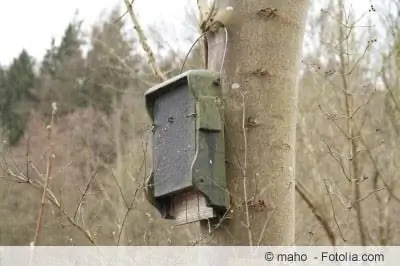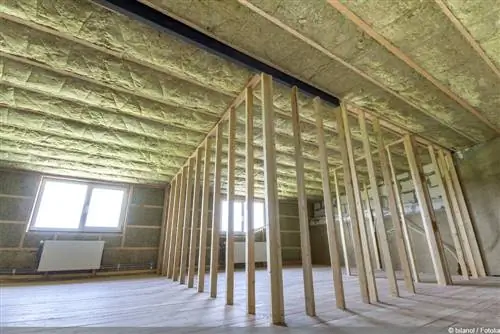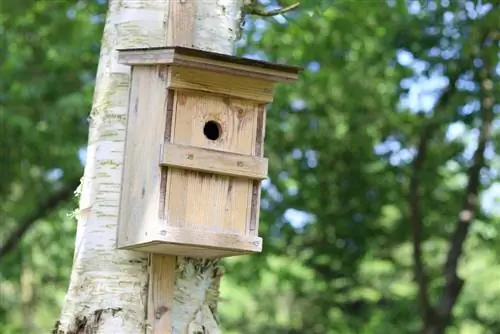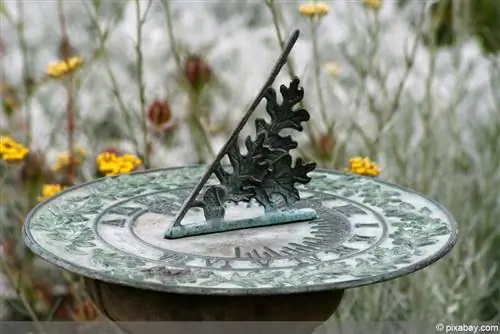- Author admin [email protected].
- Public 2023-12-17 03:39.
- Last modified 2025-01-24 12:45.
There is a great housing shortage among tree bats. Their traditional retreats for overwintering and raising their young are falling victim to merciless deforestation. It is explicitly the old, hollowed-out trees that provide a roof over the heads of endangered bat species. If you would like to make a contribution to the preservation of these unique mammals, you will find the instructions for building a bat box here with tips on how to hang it correctly. The presented model is designed in such a way that different species of bats can settle here. Placement on the house wall or in stable buildings is also possible.
List of components
The most recommended types of wood are rough-sawn pine, fir and spruce, which must under no circumstances be treated with impregnation products. Even biological means are completely unsuitable because the small bat claws can only find sufficient grip on a surface that is as rough as possible. Ideally, you should use wooden components that are 20 to 25 millimeters thick. These components are required: (dimensions in length x width x thickness)
- 1 hanging rail with 700 x 40 x 20 mm
- 1 roof panel with 130 x 310 x 20 mm
- 1 base plate with 210 x 30 x 20 mm
- 1 board as a back wall with 450 x 250 x 20 mm
- 1 board as a front wall with 350 x 250 x 20 mm
- 2 side walls, tapering from 300 x 40 to 20 x 20 mm
So that the wood inside the box is really rough enough, it is also scratched across the grain using a sharp device such as a screwdriver. Alternatively, you can create small grooves with a saw. Since the back wall also functions as an approach board, it is provided with grooves from top to bottom for clipping on arrival.
Make a bat box
The bat box in these building instructions has a sloping front wall. This attribute gives animals of different species the opportunity to freely choose their favorite place. Bats love a cramped hanging space where they have both their stomach and back contact with the wood. In these steps you will assemble the house:
- Screw the rear panel from the inside to the hanging strip so that no metal parts protrude into the interior
- Glue the side walls to the back wall
- Now screw or nail the floor to the front wall
- Then glue the front wall to the side walls
- Finally attach the roof
- Glue all cracks except for the access slot for a draft-free box
If the body is finally wrapped with tar paper, this measure effectively prevents the dreaded woodpecker strike. The approach bar is excluded from this. The bat house also cleans itself through this opening as the droppings fall through.
Alternative approach
Since the front wall of the bat box is set at an angle, you can keep the gap between the roof and the body extra small if you follow these instructions:
- First screw or nail the floor to the front wall
- Then glue the side walls to the front wall
- Now connect these parts to the back wall
With the basic box in your hands, cut the top end of it with the circular saw so that the roof can be attached there precisely. Then wrap the box in tar paper and attach it to the hanging rail.
Tip:
The insertion gap between the floor and the rear wall must not be smaller than 20 mm or larger than 25 mm. In this way, pregnant females can also fit through, while birds are not allowed in.
Hanging correctly
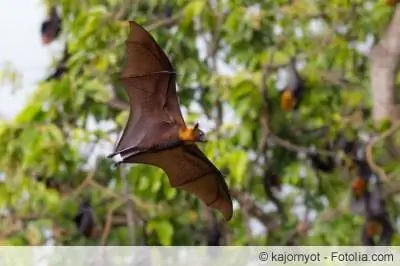
The replacement bat quarters you make yourself are ideally hung in groups of 5 to 7 boxes in groups of trees or on the house. To do this, choose a height of 3 to 5 meters. So that the bats can fly freely to their home, there should be no branches or leaves in the immediate vicinity. Due to their high resin content, conifers are rather unsuitable for hanging a bat box. There is too great a risk that the wings will come into contact with the resin and stick together. Freely hanging boxes that sway back and forth are avoided by bats.
An orientation in a south-west direction is optimal, as it quickly becomes too hot in the wooden box in direct sunlight for the exclusively nocturnal mammals. Day sleepers have no objection to one or two warming rays of sunshine. A street lamp or a bright neon sign nearby, on the other hand, is perceived as extremely annoying.
A quiet location is of vital importance for the hanging area. The nocturnal animals urgently need sufficient periods of rest. The less the bats are disturbed, the more comfortable they feel in their new home and keep coming back there. This also applies to the local weather conditions. A bat box in a windswept location is unlikely to attract any residents. However, if you choose a place in the lee, the construction will be very popular with the fluttering residents.
Tip:
It can take weeks and months until a bat box is colonized, so a little patience is required from the human builder.
Insulation with insulating material is contraindicated
It is well-intentioned by bat-friendly DIYers if they want to winterize the bat box using double walls and Styrofoam. However, field tests by animal welfare organizations have shown that such hibernation boxes have significant disadvantages. First of all, these boxes are too small because bats prefer to hibernate in very large groups. In addition, there is a risk of attracting ants. The busy insects create tunnels in the insulation material and carry it outside. As a result, the position of the bat's apartment is visible from afar due to the snow-white material, which many predators know how to use to their advantage.
Cleaning
Since these building instructions provide a gap at the bottom as an entrance, cleaning should generally not be necessary as animal droppings fall through. If in doubt, it is still possible to sweep out the box with a twig. Of course, this cleaning is only possible when the residents are not at home, which can be the case outside of the winter rest period from June to September.
Bat protection is active nature conservation
The bat is one of the most endangered species in Europe. The destruction of their natural habitat, the exorbitant use of insecticides and pesticides are just a few examples of the reasons for extinction. As insect eaters, bats are an indispensable part of ecological balance. At night they hunt for pests that would otherwise quickly get out of hand. Mosquitoes, gnats and nocturnal butterflies are on their menu. Each of the 30 native bat species has its preferred prey and hunts in a very individual way, so that there is no competition for food. By making a bat box or several specimens, you are making a valuable contribution to the conservation of these important insectivores. In addition, the following measures also make a significant contribution to protecting noctule sailors and colleagues:
- Planting mixed hedges
- Create dry walls and let nature plant them
- Leave hollow tree trunks in the garden and do not dispose of them
- Create a pond, ideally complemented by a stream
- Do not use insecticides so that the bats can find enough food
- Attach a small board to open rain barrels as an exit option
In addition, various plants have proven to be particularly insect-friendly, which in turn benefits bats. These include, among others:
- Common viburnum (Viburnum opulus)
- Meadowsweet (Filipendula ulmaria)
- Daylily (Hemerocallis citrina)
- Meadow sage (Salvia pratensis)
Blackberries (Rubus fruticosus) and raspberries (Rubus idaeus) as well as blackthorn (Prunus spinosa) and the apple tree (Malus domestica) are also considered ideal candidates for the bat-friendly natural garden.
Conclusion
Every home and garden owner can make a valuable contribution to saving bats from extinction. Alleviating the housing shortage can be achieved using simple means. Since the natural retreats are becoming increasingly scarce, you should provide the ingenious insect eaters with replacement quarters. Following these building instructions, you can make a bat box yourself in no time. The tips for professional hanging show where the new home will be accepted most quickly by the fluttering residents. If you make the garden insect-friendly, the table is richly set for the endangered mammals.

